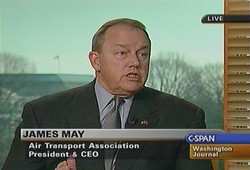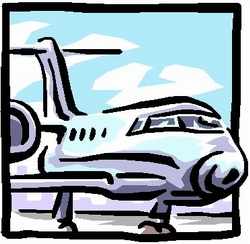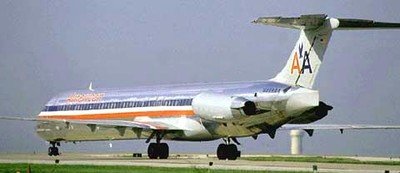But Airline Group Also Expresses Concerns
The Air Transport Association of America (ATA), the industry
trade organization for many US airlines, issued the following
statement Wednesday in response to the release of the Federal
Aviation Administration (FAA) Reauthorization Bill and FAA Cost
Allocation Study on the reauthorization of the Airport and Airway
Trust Fund (AATF).

ANN presents the statement, unedited, below:
"While we applaud this proposal as a good step forward in
advancing the reauthorization debate and welcome its recognition of
the inequity of forcing airlines and their customers to subsidize
other system users, we have deep concerns over a number of elements
of the proposal," said ATA President and CEO James C.
May.
May (shown at right) offered the following
observations:
Support for Rational Funding
 ATA supports the FAA movement
to correct the unfairness of the current funding system by
proposing more reliable, predictable and equitable funding going
forward. While more work remains to fine-tune the allocation
process, we see the FAA endorsement of a cost-based funding
mechanism for both airlines and other air traffic control (ATC)
system users as a step in the right direction. In addition, the
proposal accommodates the general aviation community’s desire
to pay their fair share of the cost for using the system through a
use-based, calibrated fuel tax.
ATA supports the FAA movement
to correct the unfairness of the current funding system by
proposing more reliable, predictable and equitable funding going
forward. While more work remains to fine-tune the allocation
process, we see the FAA endorsement of a cost-based funding
mechanism for both airlines and other air traffic control (ATC)
system users as a step in the right direction. In addition, the
proposal accommodates the general aviation community’s desire
to pay their fair share of the cost for using the system through a
use-based, calibrated fuel tax.
Elimination of Corporate Jet Subsidy
ATA is pleased that FAA has been able to quantify the subsidy
that airline passengers and shippers have been forced to pay to
cover the cost of all other users of the ATC system. Today,
airlines contribute 94 percent of revenue into the Trust Fund but,
according to the new FAA Cost Allocation Study, airlines drive less
than 73 percent of ATC costs. While that new calculation continues
to reflect a subsidy we will be addressing, it is a major step
forward.
Establishment of Bonding Authority
ATA also is pleased that the administration is providing FAA
with $5 billion in borrowing authority -- and not relying on
new taxes or fees -- to build a 21st century ATC system.
(Editor's Note: this assertion appears to
contradict the FAA's earlier statement that its funding
proposal "relies on a combination of user-fees, taxes
and a federal government contribution to support the
development of a new, satellite-based, air traffic control
system.") This will provide FAA with the funding needed to
move from a ground-based, human-centric ATC system, to a
satellite-based system that will allow us to meet future
demand.
Confusion over Congested Airspace versus Congested
Airports
 The
administration’s proposal includes a fee for operating in the
"most congested" airspace, but improperly pegs that fee to large
airports, and that concerns us. By tying the fee to the airport,
the FAA does not address the real congestion issue in surrounding
airspace. For example, 20 percent of en route traffic in the New
York area comes from general aviation traffic that does not use
large airports in the area and no rationale exists for the
continuation of a subsidy.
The
administration’s proposal includes a fee for operating in the
"most congested" airspace, but improperly pegs that fee to large
airports, and that concerns us. By tying the fee to the airport,
the FAA does not address the real congestion issue in surrounding
airspace. For example, 20 percent of en route traffic in the New
York area comes from general aviation traffic that does not use
large airports in the area and no rationale exists for the
continuation of a subsidy.
Use of Aircraft Weight as an "Artificial Proxy"
The proposal’s use of weight as a factor in assessing
cost-based funding is of enormous concern to ATA member airlines.
FAA’s own study found the number of onboard passengers,
aircraft weight and size were irrelevant to the actual costs of
using the ATC system. Further, the Government Accountability Office
has determined that incorporating weight into a cost-based formula
weakens the link between use and costs. Heavier planes would be
required to contribute more for traveling the same distance, even
though they impose no greater costs. This old-school thinking has
no place in a modern, fair funding system.
Failure to Meaningfully Reform Airport Funding
The administration also missed the mark on its airport funding
proposals. For one, the Airport Improvement Program (AIP) includes
$1 billion in subsidies for non-commercial airports paid by
commercial airline passengers. Worse still, the administration is
proposing to raise passenger "head taxes" in the form of the
passenger facility charge – this federally approved, local
ticket tax could cost passengers an extra $2 billion annually,
without any meaningful airline or FAA controls. In essence this
will provide more money on top of the approximately $14 billion
already being spent annually on our nation’s airports. This
is more about meeting airport wants rather than airport needs.
"ATA views the administration’s proposal as a starting
point for Congress to draw upon as it begins its consideration of
the crucial future course of our nation’s air transport
system," said May. "We look forward to working with Congress and
the administration to build a 21st century ATC system supported by
equitable, sustainable funding."

ATA airline members transport more than 90 percent of all US
airline passenger and cargo traffic.
 ANN's Daily Aero-Linx (05.06.25)
ANN's Daily Aero-Linx (05.06.25) ANN's Daily Aero-Term (05.06.25): Ultrahigh Frequency (UHF)
ANN's Daily Aero-Term (05.06.25): Ultrahigh Frequency (UHF) ANN FAQ: Q&A 101
ANN FAQ: Q&A 101 Classic Aero-TV: Virtual Reality Painting--PPG Leverages Technology for Training
Classic Aero-TV: Virtual Reality Painting--PPG Leverages Technology for Training Airborne 05.02.25: Joby Crewed Milestone, Diamond Club, Canadian Pilot Insurance
Airborne 05.02.25: Joby Crewed Milestone, Diamond Club, Canadian Pilot Insurance






